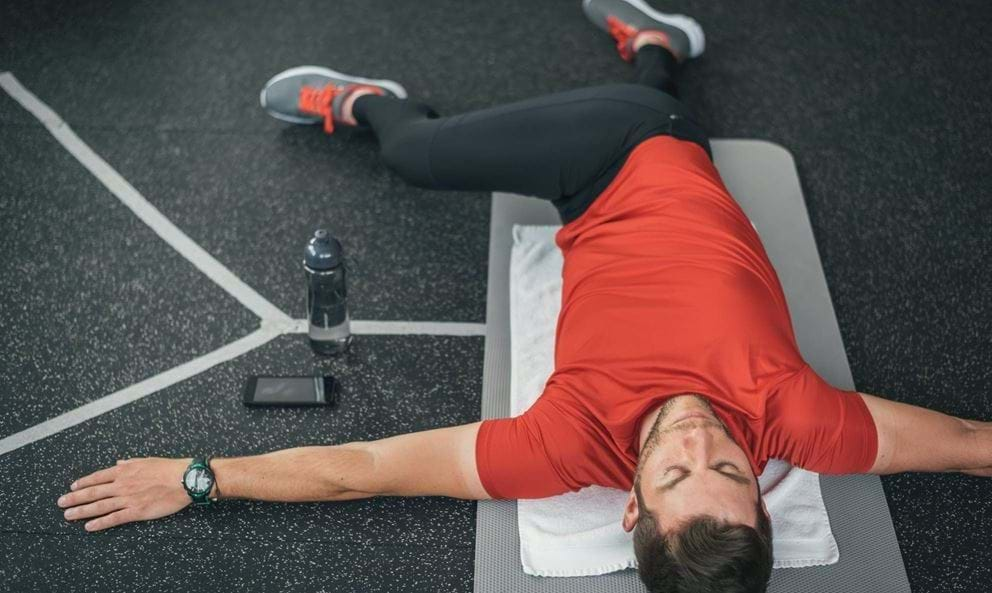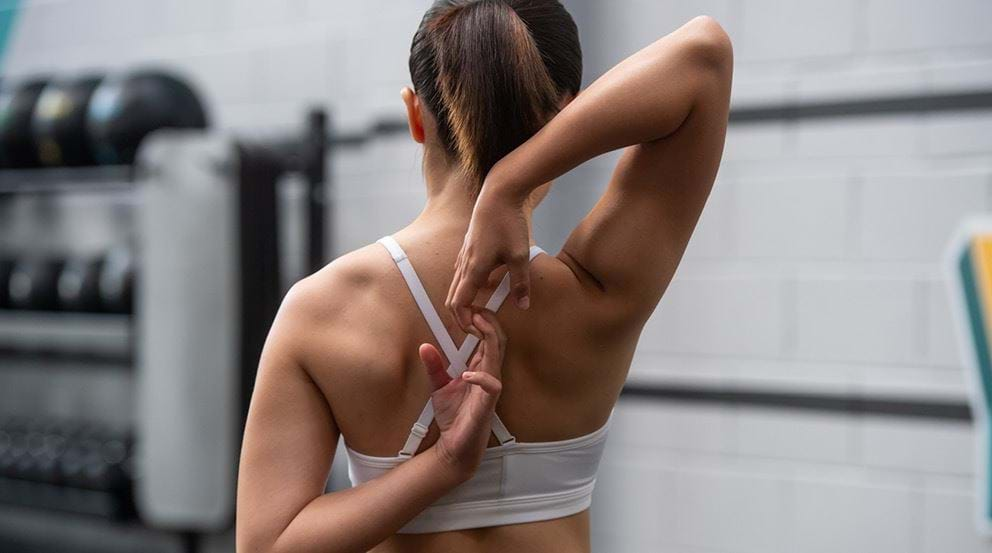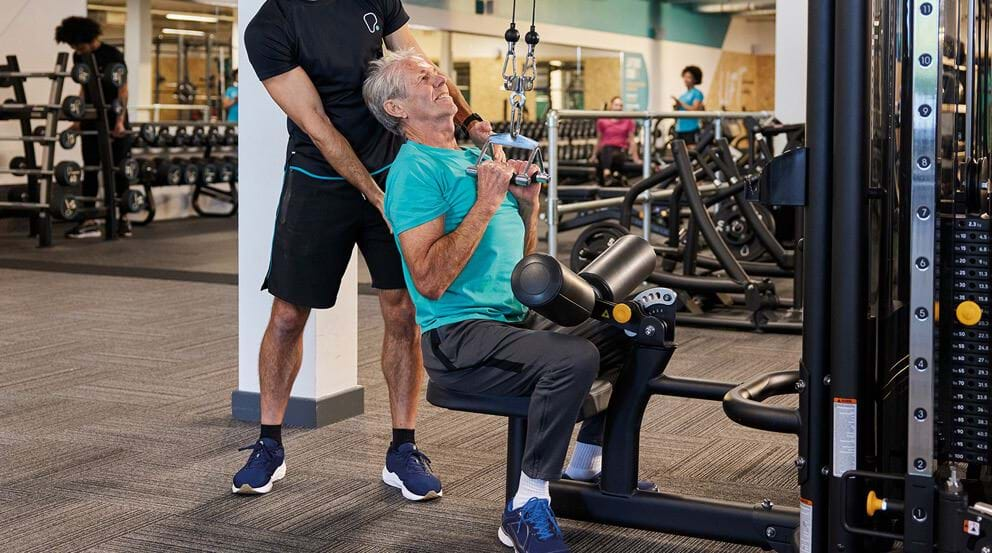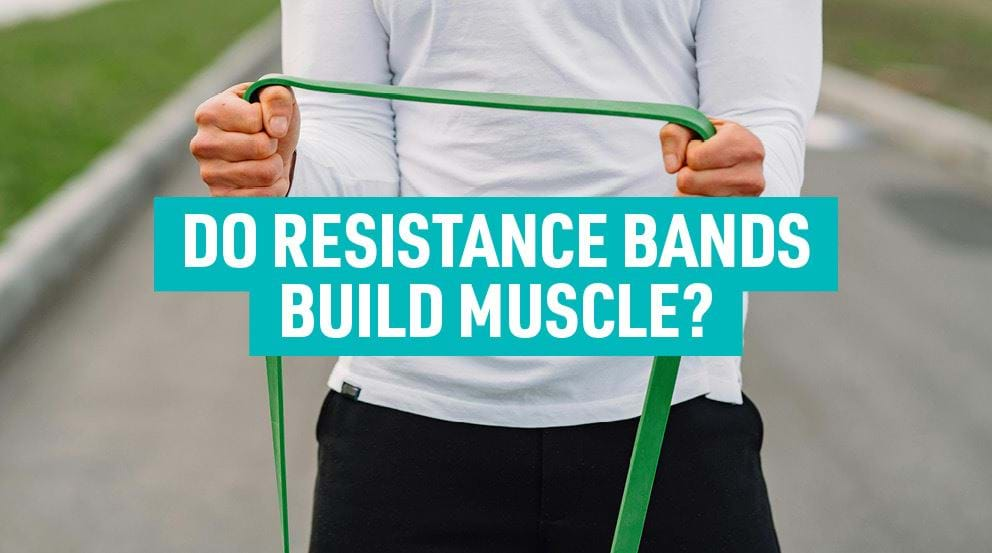Mobility Exercises To Ease Tension And Improve Posture

If you've been finding you've moved less and sat more recently, don't worry, you're by no means alone. While there are many benefits from an increase in working from home, you may have found it's been having a negative effect on your joints and muscles. Muscle soreness, tension and tightness could all be a result of poor mobility, but don't worry, this guide will show you what to do, to start improving yours.
This guide will cover:
What is mobility?
When it comes to your body, mobility is quite simply the ability to freely move yourself using your muscles and joints, ideally without requiring any support or feeling any stiffness or stress. So, raising your arms, swinging your legs, rolling your shoulders, moving into a seated position, bending over... these all require mobility.
Mobility is generally linked with a good range of movement, healthy joints, strong muscles, stability and flexibility - all of which can usually be improved with regular exercises and stretches. While there are many types of exercises that just focus on how to improve flexibility (e.g. increase your body's ability to move through its full range of motion), or perhaps boost your stability (e.g. to help with balance), full mobility really takes a combination of all of these different elements so you can move your muscles in different ways.
Why is mobility important?
Mobility is what helps you move around - keeping your posture sturdy and everyday activities problem-free. If your mobility starts to deteriorate in any way, you may struggle to move in a free, unsupported manner. So if, for example, you suffer with poor hip or knee mobility, you could find it painful or difficult to walk without the support of a stick or wheelchair.
The benefits of good mobility include:
- Increased flexibility
Having good mobility means you can move freely and easily, and you're more likely to be more flexible and supple, which is great in helping improve your performance and the results you get in the gym. With improved flexibility, your body will be able to achieve a full range of motion when performing various exercises. On the other hand, if your muscles are tight and not flexible, you won't be able to perform the full range of motion, which often means you won't be recruiting the muscles you should be using, or placing enough tension to exert a big enough stimulus to help grow muscle. So essentially, this means your muscles won't be able to get as powerful, strong or build as they could if you were more flexible.
- Get better results
If you have good mobility, your body can get into positions easier and perform movement patterns more efficiently. This can help you get better and faster results as you can maximise the work you do during exercise whilst targeting the right muscles, and be more likely to lift a heavier load which can improve your strength and help improve muscle mass in the long run. Improving your mobility can also help to boost your performance and technique in activities like running or competitive sports and can help lower the risk of injury.
If your mobility is restricted as you work out, then smaller, weaker assistance muscles will be engaged to compensate, which could start to feel painful. If you find that certain exercises lead to pain, it could be that the muscle is underdeveloped causing tension and soreness in the joints.
- Improved quality of life
Good mobility supports the proper functioning of your body. This will improve your quality of life as it will help to prevent injuries, as well as easing recurring discomfort or pain that could be mentally draining or frustrating, and limiting the progress you make in the gym. These benefits will also support a positive mindset and happy mood so you can enjoy your time and achievements made in the gym!
- Better posture
When your body is able to move well, your body will be in better alignment and have a better range of movement, so not only will this enable you to perform optimally during exercise and decrease the risk of injury, you will also improve your posture which can instantly make you look and feel better.
What causes limited mobility?
There are a range of issues that could lead to restricted mobility. These could include (but aren't limited to):
- Older age - aging can affect bone density, muscle mass and strength, which can result in stiffer, less flexible joints
- Injury - if you injure a muscle, you could experience pain, swelling and stiffness, all of which can limit mobility
- Low activity levels - if you're living a fairly sedentary lifestyle then you're missing out on the continual strengthening and mobilising of your muscles and joints. As they get weaker, you could suffer from increased tension and stiffness
- Chronic diseases (e.g. diabetes, osteoporosis or arthritis) - some diseases can affect the joints, flexibility and mobility, causing pain and stiffness
- Obesity - extra weight can add additional pressure to joints and muscles, meaning they need to work harder to perform well. If they struggle, this could lead to mobility issues and injury
If you don't suffer with any major illnesses or injuries, then it's very likely that lack of mobility is being exacerbated by (if not caused by) a more sedentary lifestyle, such as an increase in time spent at a desk, in front of the TV or driving instead of walking. Luckily, if this is the case, then there are steps you can take to improve your mobility again.
What are mobility exercises?
Mobility exercises are movements, stretches and actions that, when repeated, will help to improve your mobility by boosting your muscle strength, flexibility and stability. In many cases these exercises require no equipment, but you can also integrate items such as resistance bands, weights and balancing balls to increase the intensity of each movement.
Yoga, pilates and barre are all excellent activities for increasing mobility, and also for easing stress which can cause muscles to tense up. Most warm ups, cool downs and dynamic stretches will also help with mobility, and foam rolling after a workout is another popular approach - which has been shown to ease tight muscles by breaking up scar tissue and improving circulation.
When to do mobility exercises
A lot of mobility movements can be done at any point throughout the day, so are a perfect way to ease tension and soreness when it hits - especially good if you're sitting all day for work.
Many people incorporate mobility exercises into their warm ups, which is a great way to prepare your body for a workout and loosen up any stiff joints and muscles ahead of your main exercise. Likewise, you may find you'd like to include some mobility-boosting stretches in your cool down, helping to ease any tension that may have flared up during your workout.
However, you can also focus your whole workout on just improving your mobility - exercises such as yoga or pilates are a great way to improve your strength, flexibility, stability and range of movement (and they're excellent stress busters too).
Hip Mobility Exercises
If you spend a lot of your day sitting in front of your computer, you could find you start to suffer with tight or sore hips. Including mobility exercises into your day, such as the examples below, may be beneficial to loosen these joints, relieve tension and improve your mobility in this area.
- Quadrupled hip CAR (also known as kneeling hip car): start on all fours with your hands below your shoulders and knees below your hips. Keeping your knee bent at a 90 degree angle, start to move your right leg forward at the hip until your knee meets your elbows. Then, again, keeping your knee bent in the same position and only moving your hips, rotate the leg in as wide a circle as possible around the right side of your body to the back and then return to starting position. Try 10 controlled reps on each leg. Rest 30 seconds to a minute in between. Complete 3 sets.
- Squat ankle rocks: Standing with your feet a little wider than shoulder width apart, shoulders back and your core tight, ease yourself down into a deep squat. Resting your arms between your legs (some people actually like to rest their elbows on the insides of their knees for this) gently and slowly rock from one hip to the other. You can also rock in small circles, first in one direction, then the other. Try holding the position for 10 seconds and see how this feels. As you get more comfortable in this position you can start to lengthen the time you hold the position as your mobility improves.
- 90/90 rotations: Start by sitting on the floor, with a straight back, your feet on the floor and your legs bent in a v-shape. Moving your legs at the hip, but keeping your legs bent, gently drop both knees to the floor towards the right. Turn your upper body to face right, and shift your bodyweight until your right leg (bent at a 90 degree angle) is in front of you and your left leg (also bent at a 90 degree angle) is to your left hand side, or slightly further back if possible. Hold for around 60 seconds before twisting back round to the starting position. Repeat on the left hand side.
- Bodyweight squat with reach: Perform a regular bodyweight squat (as shown in our squat guide, but as you lower your body, raise your arms straight above your head, lowering them back down as you come out of the squat. Hold the squat position for 5 seconds and see how you feel. You can always extend the duration if you feel comfortable in the position. Complete 5 controlled reps.
You can find more exercises to help hip mobility here.
Shoulder mobility exercises
The shoulder joint is extremely complex with a wide range of movement. Poor posture or an unsuitable work set up can cause stiffness and soreness in the area, as well as repetitive strain, causing pain when you lift or move your arms. The exercises below can help to stretch out your shoulders and release tension in these joints.
- Shoulder dislocates: You can perform this using the light bar located in our studios next to our mini plates or a lightweight resistance band. Stand tall with the bar or band in front of you at about slightly wider than shoulder width apart. From this position raise your arms up and over your head and bring it behind your back whilst ensuring a straight back. If your chest is feeling tight, you may want to position your hands slightly wider. Ret 6-10 reps and adjust your grip to a comfortable position if needed.
- Alternating banded dislocates: Using a light resistance band, hold the band out in front of you about slightly wider than shoulder width apart. Raise your arms to about shoulder height whilst engaging your back muscles. You should feel a slight tension in the band. Extend one arm out to about 45 degrees and keep this arm locked out, and bring the other hand back behind you as if you're doing a back stroke. You should feel the tension in the band increase as you bring that arm back. Try to keep you back engaged at all times throughout the movement. Try 5 reps on each side and see how you feel. Complete 3 sets.
- Forearm t-spine rotations: Begin on all fours with your hands below your shoulders and your knees below your hips, before dropping your forearms so they're flat on the floor. From here, and keeping the same bend in your elbow, start to twist the right arm upwards towards your right-hand side, twisting your torso with it, so you can keep your eyes fixed on your right hand. You should feel a comfortable stretch all through your shoulders and upper body. Ease back to the starting point. Try 5 reps before repeating on the other side. Complete 3 sets.
- Shoulder axial rotations: Standing tall with arms out to the sides around shoulder height. Clench your fists with your palms facing forwards whilst engaging your back muscles, keeping the shoulders back away from the ears. Slowly rotate your palms till your wrists are facing backwards and return back to palms facing in front and repeat for 10 times.
Ankle mobility exercises
The ankles are a fairly fragile joint that get put through their paces on a daily basis. Any weakness around the ankles can easily lead to soreness, stiffness and even injuries such as sprains. So, it's a good idea to take care of these areas and keep them strong and mobile. Check out the movements below for ankle-strengthening exercise ideas.
- Banded ankle dorsiflexion: Using a looped resistance band (or just tie the ends of a regular resistance band so it forms a large loop), loop one end around a table or chair leg (or other type of post low to the ground). Kneeling on your left knee, place the band around the front of your right ankle and place your heel on the floor in front of you, with your knee bent to 90 degrees. Press your knee forward until you feel a stretch in the calf and Achilles tendon. Hold for around 30 seconds before leaning back. Repeat for 2 or 3 times before repeating on the other leg.
- Wall calf stretch (knee bent): Stand facing a wall, with your hands around shoulder height on the wall in front of you. Move your right leg back about a step and keep both feet on the floor with both knees bent. Gently ease your hip and chest forwards towards the wall until you feel a stretch in the back of your calf. Hold for around 30 seconds, before stepping back and repeating with the other leg. Repeat two to three times with each leg.
- Calf foam rolling: You'll need a foam roller for this movement. Sit on the floor with your legs out in front of you and your back straight. Position the foam roller under your calves, just above your knees. Lift your hips off the ground, and use your hands to roll back and forth across the roller, between your ankles and your knees. Continue for around 60 seconds.
- Multi direction ankle motions with toe taps: Imagine you're standing in the centre of a clock face. Balancing on your left leg, lift your right foot and, pointing your toe as far as you can reach, tap where each number of the clock would be (e.g. straight in front of you for 12, to your right for 3), returning to centre after each tap. Continue for around 60 seconds before repeating with the other foot.
Back/thoracic mobility exercises
Your spine area (thoracic) and back are often one of the quickest areas to suffer from long periods of sitting or slouching, often the result of poor posture putting pressure on the wrong muscles. The exercises described below will help to open out your back, ease tension and strengthen the muscles to help improve your posture.
- Cat cow: This gently flowing yoga move begins in all fours with your wrists below your shoulders and knees under your hips. Keep your neck straight and your gaze downwards. Start to drop your belly towards the floor, tilting your hips upwards, your shoulders back and lift your chin and chest until you're looking upwards - this is called cow pose. After a couple of moments in this position, gently move your body back through the starting position before moving on to cat pose - keep drawing your belly upwards, tilt your hips downwards and your back rounded to the ceiling (like a stretching cat). Repeat around 10 times.
- T-spine opener: Begin by lying on your side, with your bottom leg straight and the upper leg in front of you, bent at a 90 degree angle. Ideally, your knee will rest on the floor, but feel free to use a pillow or some kind of support if this isn't comfortable. Stretch both arms out in front of you, with the bottom one resting on the floor. Gently stretch your upper arm further away from your body and then lift it away from the floor, arching over your body until it rests on the floor on the other side of your torso and your arms form a t-shape. Hold this pose for a few seconds before slowly returning your arm to the starting position. Try this for 5 times on each side for 2 sets.
- Thoracic foam roller: Take your foam roller, place it horizontally on your mat, and lie on it so it sits across the middle of your back, a little lower than your shoulder blades. Keeping your core engaged, your neck straight and your gaze to the ceiling, clap your hands together with your arms straight above your face. Ease your arms back over your head, as if they're moving towards the floor behind you. Lean back so you're arching over the foam roller just a few inches and hold for a few moments, making sure not to over extend here - this should just be a gentle movement. Then ease your way back up to the starting position. Repeat 12 times.
- Tall kneeling alternating blackburns: Begin in an upright kneeling position, with your back straight and shoulders back. Hold your right hand behind your head and your left hand at the base of your back. At the same time, you'll need to stretch out both arms, so your right hand is straight above your head and your left hand is down at your side. Keeping them extended, sweep your right hand in an arc all the way down until it gets to your thighs, before bending your arm to rest on your lower back. Simultaneously, you'll be doing the opposite with your left arm, sweeping it upwards until it rests behind your head. Repeat in the other direction. Repeat 12 times.
- Thread the needle: Start on all fours with your knees under your hips and your hands under your shoulders. Lean so your left side is holding your balance and start to 'thread' your right hand through the space just below your left arm. If you can, keep going until your right shoulder is on the floor. Hold this position for around 10 seconds before returning to the starting position. Repeat 5 times before repeating with the other arm.
One of the best ways to prevent mobility loss is to simply keep your body moving, so find a gym near you and get going today. If you find you're already struggling with mobility, then consider booking in a session with one of our expert Personal Trainers, they'll be able to provide advice, guidance and support for building strength and flexibility. Not ready for the gym yet? Then download the free PureGym app (even if you're not a member!) - it has lots more workouts tailored for beginners.


